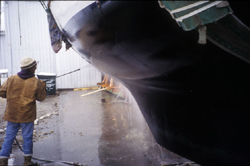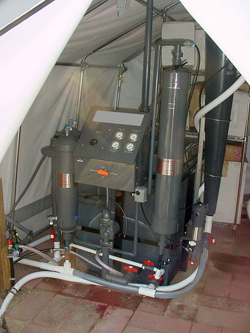New York Sea Grant's
Marina Pollution Prevention Web Site
Section 3:
Hauling
and Storing Boats - Pressure
Washing
Potential Environmental Impacts
When the marine
organisms that accumulate on the bottom of a vessel are removed
by pressure washing, the water contains  fragments
of bottom paint and hull materials are often chipped off in the
process as well as dissolved constituents from the paint. Copper
and zinc in the water can be harmful to some marine animals and
plants at concentrations of parts per billion (one drop in 21,000
gallons). These pollutants can get washed into the marina basin.
Sediments contaminated with copper can also cause problems and
extra expenses related to disposal of materials dredged from the
marina basin.
fragments
of bottom paint and hull materials are often chipped off in the
process as well as dissolved constituents from the paint. Copper
and zinc in the water can be harmful to some marine animals and
plants at concentrations of parts per billion (one drop in 21,000
gallons). These pollutants can get washed into the marina basin.
Sediments contaminated with copper can also cause problems and
extra expenses related to disposal of materials dredged from the
marina basin.
Best Management
Practices
Avoid in-water
bottom cleaning or hull scraping or any process that occurs underwater
to remove antifouling paint from the boat hull. While this is
a popular practice for racing sailboats prior to a race to reduce
drag, it makes it impossible to capture and treat what's cleaned
from the boat bottom.
Pressure wash
waste water should not be discharged directly to surface waters
or the ground without a permit from your  state
environmental agency. To the extent possible marina facilities
should try to collect the wash water, treat it, and either dispose
of it at a sewage treatment plant (through discharge to a sanitary
sewer or by hauling using a licensed hauler) or recycle it. Discharge
to the sanitary sewer requires local water pollution control authority
approval.
state
environmental agency. To the extent possible marina facilities
should try to collect the wash water, treat it, and either dispose
of it at a sewage treatment plant (through discharge to a sanitary
sewer or by hauling using a licensed hauler) or recycle it. Discharge
to the sanitary sewer requires local water pollution control authority
approval.
Where feasible,
wastewater from the washing operation may be collected and reused
through a closed loop pressure wash treatment system. For examples
of manufacturers of wash water treatment and recycling systems,
click
here.
 Minimize
the use of detergents, caustic cleaners and other additives when
pressure washing.
Minimize
the use of detergents, caustic cleaners and other additives when
pressure washing.
Minimize the
amount of pressurized water used when boats are power washed.
For example, wash the hull above the waterline by hand.
Regulatory
Issues
A hazardous
waste determination should be conducted on collected pressure
wash wastewater to establish whether or not disposal of the collected
material is subject to hazardous waste regulations [40 CFR
262.11, click
here]. For more information on New York hazardous
waste testing requirements, click
here. While stored on-site, it must be managed
in accordance with hazardous waste storage requirements [40
CFR 262.11, click
here]. For more information on New York's Hazardous
Waste Regulations and storage requirements, click
here.
Pressure wash
waste water should not be discharged to surface or ground waters
without authorization from the state under the State Pollutant
Discharge Elimination System (SPDES). For more information on
the SPDES program in New York, click
here.
If there is
a stormwater discharge from your facility and power wash outdoors,
you may have to register for a General Permit for the Discharge
of Storm Water Associated with Industrial Activity ("Storm
Water General Permit"). For more information on stormwater
permitting in New York, click
here.

